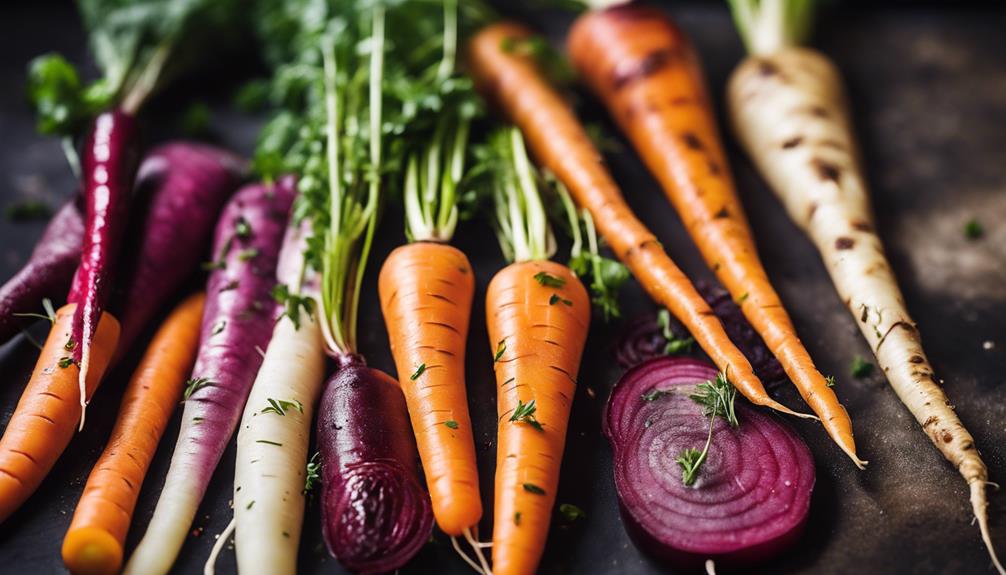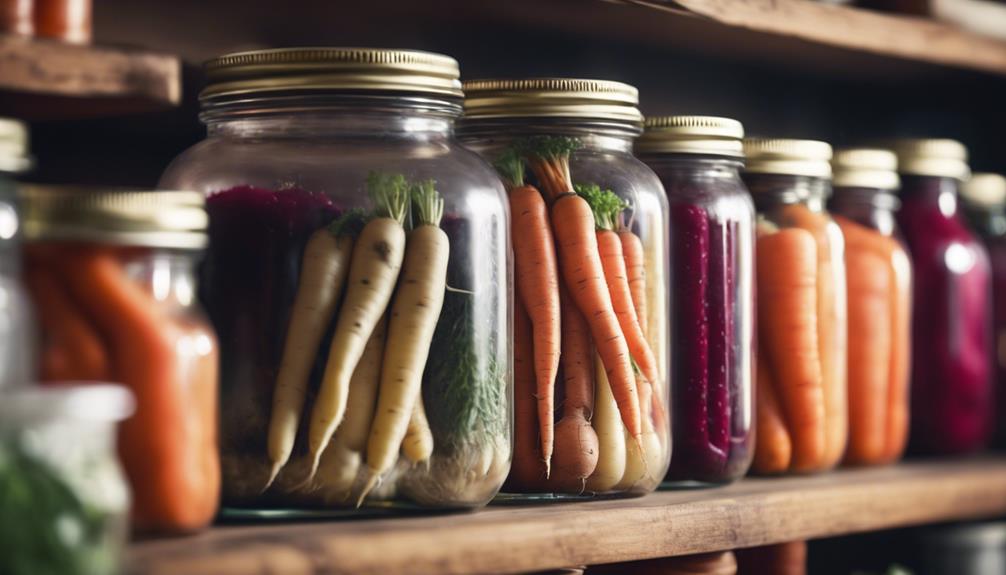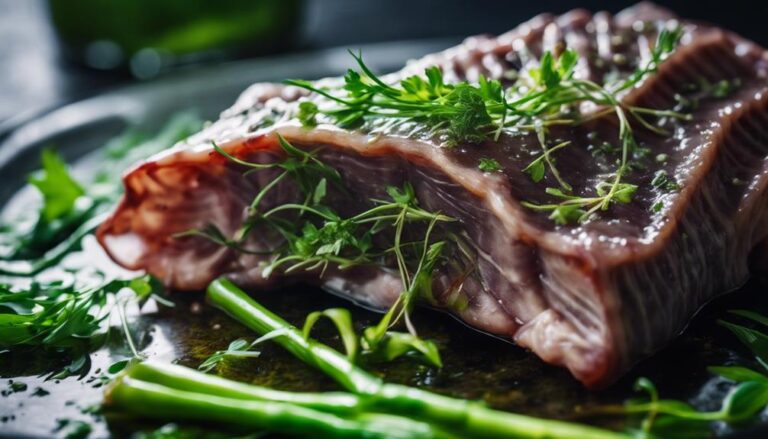Sous Vide Roasted Root Vegetables
Achieve peak flavor and nutrients with sous vide roasting for root vegetables. Control doneness and infuse herbs like rosemary and thyme precisely. Sous vide guarantees consistency and herb aromas in your veggies. Mastering this technique enhances taste and health benefits, making your dish a culinary delight.
What You Will Learn Here
- Sous vide offers precise temperature control for evenly roasted root vegetables.
- Infuse aromatic herbs like rosemary for enhanced flavor in sous vide roasted root vegetables.
- Adjust cooking time to control vegetable firmness and texture in sous vide preparation.
- Sous vide retains moisture and nutrients better than traditional roasting methods.
- Enjoy consistent doneness and flavorful results with sous vide for roasted root vegetables.
Root Vegetables' Culinary Evolution

Root vegetables have undergone a fascinating culinary evolution over the centuries, adapting to various cooking techniques and flavor profiles. Their rich history, from ancient civilizations to modern-day gastronomy, showcases their enduring popularity and significance in global cuisines.
Additionally, the nutritional benefits and versatility of root vegetables make them a staple in diverse culinary practices, offering a spectrum of flavors and textures for culinary exploration.
History of Root Veggies
Over centuries, the culinary evolution of certain underground vegetables has played a significant role in shaping various cuisines around the world.
Root vegetable origins can be traced back thousands of years, with early cultivation likely starting in Asia and the Middle East. These vegetables, such as carrots, turnips, and beets, weren't only valued for their taste but also for their ability to thrive in diverse climates.
Their culinary significance lies in their versatility – they can be roasted, mashed, pickled, or consumed raw, offering a wide range of flavors and textures.
Root vegetables have been a staple in diets globally, providing essential nutrients and adding depth to dishes through their earthy, sweet, or nutty profiles.
Versatility in Cooking
Having established the historical roots of these underground vegetables, the culinary world's fascination with the versatility of root vegetables in cooking stems from their ability to transcend traditional culinary boundaries. Root vegetables, such as carrots, beets, and parsnips, have evolved in the culinary scene due to their adaptability to various cooking methods. When employing sous vide techniques, these vegetables retain their natural flavors and nutrients, enhancing the overall dish. The beauty of root vegetables lies in their ability to pair effortlessly with a myriad of flavors, leading to endless possibilities for creative flavor combinations. Below is a table highlighting some popular flavor combinations for sous vide root vegetables:
| Flavor Combinations | Vegetables |
|---|---|
| Rosemary and Garlic | Carrots |
| Honey and Thyme | Beets |
| Maple Syrup and Sage | Parsnips |
Nutritional Benefits
Exploring the nutritional benefits of root vegetables reveals their significant role in modern culinary practices and their evolution as a powerhouse of essential nutrients.
Root vegetables offer a wide array of health benefits due to their high nutrient density and diverse flavor profiles. They're rich in vitamins, minerals, and antioxidants, which contribute to overall well-being and disease prevention.
Different cooking methods can affect the nutritional content of root vegetables, with techniques like sous vide preserving more nutrients compared to traditional methods like boiling.
Root Vegetables' Pantry Staples

Root vegetables commonly found in your pantry provide essential nutrients and versatility for various culinary creations. These seasonal root vegetables aren't only delicious but also pack a nutritional punch. Here are some reasons why these pantry staples are a must-have:
- Rich in Fiber: Root vegetables like carrots, beets, and sweet potatoes are excellent sources of dietary fiber, promoting gut health and aiding digestion.
- Packed with Vitamins and Minerals: These vegetables are loaded with essential vitamins such as Vitamin A, C, and K, as well as minerals like potassium and iron, which are crucial for overall well-being.
- Low in Calories: Despite their natural sweetness, most root vegetables are relatively low in calories, making them a great choice for those looking to maintain a healthy weight.
- Versatile Cooking Options: From roasting to steaming, pureeing to sautéing, root vegetables can be prepared in numerous ways, adding depth and flavor to a wide range of dishes.
Having these root vegetables in your pantry guarantees you have a nutritious and flavorful foundation for your culinary adventures.
Root Vegetable Medley Recipes
Explore a variety of flavors with these three enticing root vegetable medley recipes:
Savory Herb-Roasted Root Veggies, Citrus-Infused Root Veggie Blend, and Spiced Maple Glazed Roots.
Each recipe offers a unique combination of herbs, spices, and seasonings that enhance the natural sweetness and earthiness of the root vegetables.
Experimenting with different cooking techniques and flavor profiles can elevate your culinary skills and create a delightful medley of textures and tastes on your plate.
Savory Herb-Roasted Root Veggies
To enhance the flavors of your root vegetable medley, infuse them with a blend of savory herbs through roasting. Savory herb-roasted root veggies offer a delightful explosion of herb-infused flavors that complement the natural sweetness of the vegetables. Here is how this method enhances your culinary experience:
- Enhanced Aroma: Roasting with savory herbs releases aromatic compounds that enhance the overall sensory experience.
- Flavor Complexity: The combination of herbs adds layers of complexity to the taste profile of the root vegetables.
- Nutritional Benefits: Certain herbs used in roasting root veggies offer additional health benefits due to their antioxidant properties.
- Visual Appeal: The vibrant colors of the herbs and roasted vegetables create an enticing visual presentation that beckons you to indulge in their flavors.
Citrus-Infused Root Veggie Blend
Infuse your root vegetable medley with a lively burst of citrus flavors for an invigorating twist on traditional recipes. Citrus infusion can elevate the overall taste profile of your dish by adding brightness and acidity.
When considering root veggie pairing with citrus, keep in mind the natural sweetness of vegetables like carrots and sweet potatoes, which can complement the tangy notes of citrus fruits. The acidity from the citrus can help balance out the earthy flavors of root vegetables, creating a harmonious blend of tastes.
Experiment with different citrus varieties such as oranges, lemons, or limes to find the perfect flavor combination for your root veggie blend.
- Citrus infusion enhances flavor.
- Root veggie pairing benefits from citrus acidity.
- Sweet vegetables complement citrus tanginess.
- Various citrus fruits offer diverse flavor profiles.
Spiced Maple Glazed Roots
Spice and maple syrup combine to create a flavorful glaze for your assorted root vegetables in this recipe for Spiced Maple Glazed Roots. When using spiced maple flavoring with sous vide techniques, you enhance the natural sweetness of the root veggies while infusing them with a warm, aromatic depth. Here's how to elevate your root veggie presentation with these flavor pairings:
- Precision: Sous vide cooking guarantees that each vegetable piece is perfectly cooked and infused with the spiced maple glaze.
- Texture: The sous vide method retains the vegetables' natural crunch while allowing them to soak up the sweet and savory flavors.
- Uniformity: With sous vide, every veggie chunk absorbs the spiced maple glaze consistently, ensuring a harmonious blend of flavors.
- Versatility: Experiment with different root vegetable combinations to find your favorite flavor profiles.
Root Veggie Roasting Techniques
When roasting root vegetables, the crucial factors to take into account are:
- The temperature for roasting
- How to season the vegetables
- Variations in cooking times
Ensuring the right temperature will impact the texture and flavor development of the veggies, while proper seasoning can enhance their taste profile. Understanding the cooking time variations is essential to achieve the desired level of doneness for each type of root vegetable.
Temperature for Roasting
Employing precise temperature control is essential when roasting root vegetables to guarantee even cooking and ideal flavor development. When it comes to roasting techniques for root vegetables, maintaining a temperature of around 400°F (204°C) helps achieve the desired caramelization while preserving the natural sweetness of the vegetables.
Sous vide can also be incorporated before roasting to pre-cook the vegetables gently, locking in moisture and flavors. This method ensures that the vegetables are cooked to perfection without losing their texture or nutrients.
Seasoning Root Vegetables
To enhance the flavor profile of root vegetables during the roasting process, it is essential to strategically season them with a blend of herbs and spices that complements their natural earthy notes. Flavorful seasonings play an important role in elevating the taste of root vegetables, offering a harmonious balance of savory, sweet, and aromatic notes. When considering cooking methods, the choice of seasoning can greatly impact the final outcome. Below is a table showcasing some popular herbs and spices that pair well with root vegetables:
| Herb/Spice | Complements |
|---|---|
| Rosemary | Adds a piney aroma and enhances the earthy flavors |
| Thyme | Provides a subtle, herby taste that complements root veggies |
| Cumin | Adds warmth and depth to the overall flavor profile |
| Paprika | Offers a smoky sweetness that enhances the natural sweetness |
| Garlic Powder | Adds a savory umami kick to the roasted vegetables |
Cooking Time Variations
For best results in roasting root vegetables, adjusting the cooking times based on the type and size of the vegetables is essential to guarantee even doneness and enhanced flavors. Different root vegetables have varying densities and water content, affecting their cooking times.
Dense vegetables like carrots and beets require longer cooking times at lower temperatures to soften adequately without burning, while less dense ones like turnips and radishes cook faster.
To achieve a balanced flavor profile, consider incorporating herbs like rosemary or thyme during cooking. Pairing sweeter vegetables like carrots with earthy ones such as parsnips can create a harmonious blend of flavors.
When presenting roasted root vegetables, arranging them in a colorful and visually appealing manner can elevate the overall dining experience.
Final Thoughts
Considering the overall texture and flavor achieved through the sous vide cooking method, it's evident that the precise control of temperature and time plays a vital role in the quality of the roasted root vegetables. The sous vide benefits shine through in the consistent doneness and enhanced flavors that permeate the vegetables. When exploring flavorful pairings, think about adding herbs like rosemary or thyme during the cooking process to infuse the vegetables with aromatic notes that complement their natural sweetness.
For those with specific texture preferences, sous vide offers the flexibility to adjust the firmness of the vegetables by altering the cooking time slightly. To achieve a firmer texture, decrease the cooking time, while for a softer bite, extend the cooking duration within the recommended range. These sous vide tips ensure that you have full control over the outcome, allowing you to tailor the vegetables to your liking with precision. By embracing the sous vide technique, you empower yourself with the tools to create perfectly roasted root vegetables that delight the senses with every bite.
Frequently Asked Questions
Can Sous Vide Cooking Be Used for All Types of Root Vegetables?
You can use sous vide techniques for most root vegetables, adjusting cooking times for variations like density and size. Experiment to find the perfect timing for each type, ensuring even cooking and ideal texture.
How Can I Prevent Root Vegetables From Becoming Mushy When Sous Viding?
To control texture when cooking root vegetables sous vide, adjust cooking times based on the vegetable type. Infuse flavors by adding herbs or spices into the bag. Set the temperature according to the firmness desired for perfect results.
Are There Any Root Vegetables That Are Not Suitable for Sous Vide Cooking?
When considering root vegetables for sous vide, be mindful that some, like turnips, might not fare as well due to their strong flavors becoming intensified. Experiment with different types to find what suits your taste.
What Seasonings Pair Best With Sous Vide Roasted Root Vegetables?
For your sous vide roasted root vegetables, explore a variety of flavor combinations. Try classic herbs like rosemary and thyme or opt for bolder spices like cumin and smoked paprika. Experiment with different textures for a unique experience.
Can I Use Frozen Root Vegetables for Sous Vide Cooking?
Yes, you can use frozen root vegetables for sous vide cooking. When handling frozen produce, make sure to properly thaw before vacuum sealing for sous vide. Adjust cooking times accordingly, as frozen vegetables may require longer immersion periods for thorough cooking and flavor infusion.
Conclusion
To sum up, sous vide roasting root vegetables offers a unique and precise method for achieving perfectly cooked, tender, and flavorful results.
By vacuum sealing the vegetables and cooking them at a controlled temperature for an extended period, you can guarantee that each vegetable retains its natural flavors and nutrients.
Experimenting with different root vegetable combinations and seasoning techniques can elevate your culinary creations to new heights, making sous vide roasted root vegetables a must-try dish for any food enthusiast.











